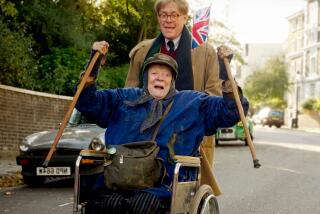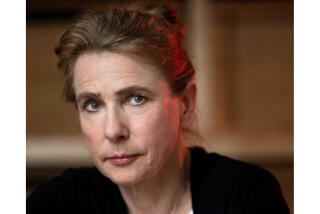G. B. Shaw--The Middle Years : BERNARD SHAW VOLUME II, 1898-1914 The Pursuit of Power <i> by Michael Holroyd (Random House: $24.95; 416 pp.) </i>
- Share via
No great figure in modern English literature had a more persistently sunny mind than George Bernard Shaw. By sunny I don’t mean the contents of his work. He was a mordant though very funny social critic and satirist, and there is a note of real despair in his two late and greatest plays, “Heartbreak House” and “St. Joan.”
Sunniness refers to his unquenchable high spirits in writing, the seeming lack of the slightest tear in his jaunty assurance. At high noon there are no shadows.
This raised suspicions among his literary contemporaries, though almost invariably mixed with admiration for his brilliance. It has fastened a tag of reserve to his reputation ever since. No shadows? Surely, then, no depths. Where is the poetry?
Shaw would reply in all manner of spritely ways. He was, of course, the master of the retort, though perhaps his truest retort was to go on writing plays. But here, in the second volume of his detailed and fiery biography, Michael Holroyd gives us Shaw’s cleverest and deepest answer.
“If I had gone to the hills nearby to look upon Dublin and to ponder upon myself, I too might have become a poet like Yeats, Synge and the rest of them. But I prided myself on thinking clearly, and therefore couldn’t stay. Whenever I took a problem or a state of life of which my Irish contemporaries sang sad songs, I always pushed it to its logical conclusion, and then inevitably it resolved itself into comedy.”
Holroyd’s second volume takes Shaw up at the turn of the century while he was still awaiting a consistent theatrical success. This would not come until 1905, by which time Shaw was 48 and author of 12 plays. The theater world of his day found him hard to digest, so Shaw resorted to publishing his plays instead of producing them, hoping to reach readers if not play-goers.
Holroyd, who carries over sporadic Freudian hot flashes from his time as a biographer of Bloomsbury, compares Shaw’s stage frustration to impotence. Shaw’s decision to publish, he terms masturbation. This is eccentric, but there is a deeper point.
It was not until they saw the plays on stage that such contemporaries as Yeats and Max Beerbohm were able to recognize, despite their reservations, Shaw’s real genius. What on the page seemed wordy and argumentative, took on powerful life once it found actors to speak through. Shaw’s ideas are characters and supremely playable.
First, though, he had to devise a new kind of theater; one that would play them. Holroyd gives a superb account of Shaw’s collaboration with Harley Granville Barker in developing, at the Court Theater, a new style of playing.
By putting the plays on in the afternoons, they were able to use first-rate actors whose evening commitments left them free. By using a repertory format, they enhanced the role of the director, with “stars” alternating big parts and small ones. It was the germ, in fact, of what five decades later would become Britain’s splendid national theaters.
It was at the Court that Shaw became a superstar, with the production of “Candida,” “John Bull’s Other Island” and several others. “John Bull” was the real breakthrough. Balfour, the Conservative prime minister, liked it so well that he insisted on coming back with his Liberal rivals, Asquith and Campbell Bannerman.
The real rocket, though, was the visit of the future Edward VII, who laughed so hard his chair broke. “In falling, he flung Shaw’s dramatic reputation high in the air,” Holroyd writes, adding, in a Shavian phrase, “Except for a period during the First World War, Shaw never fully recovered his unpopularity.”
In the 17 years the book covers--one might call it Shaw’s maturity, though his two masterpieces are still ahead--Holroyd weaves in and out of the writer’s theater work, his political activities, his journalism, his desperately irritable life with his wife Charlotte, and a host of other subjects.
He is exhaustive. There are times when the reader may suspect that Holroyd is proposing to moonlight a history of the Fabian movement and tuck it into his Shaw biography. But too much that is valuable is woven in to make this a very serious complaint.
He gives a comic and dramatic account of the uneasy rivalry between Shaw and H. G. Wells. The latter wanted to take hold of the cerebral and theoretical Fabians and bring them into practical political union with the incipient Labor Party. He was coarse, a man of action and a formidable Don Juan, and he regarded Shaw’s paradoxes (“ecstatic irresponsibilities” is Holroyd’s phrase) as so much trifling. Shaw’s lack of a real sex life also bothered him.
“I was a biologist first and foremost and Shaw had a physiological disgust at vital activities. He rebeled against them. He detected an element of cruelty, to which I am blind, in sexual matters.”
Shaw’s ill-starred pursuit of Mrs. Campbell may have foundered on a similar point. There were some embraces but not much more. At one point, the actress blamed the tenuousness of their relationship on his refusal to eat meat.
Holroyd has brought out some wonderful observations by contemporaries. Beerbohm, whom Shaw asked to draw him, remarked disdainfully on his appearance: “The back of his neck was especially bleak; very long, untenanted and dead white.”
Once established as a celebrity, Shaw could not resist posing for portraits and busts. He even appeared on teacups. The poet Rilke, who was Rodin’s secretary at the time, describes the intensity with which Shaw posed for his fellow Olympian: “He stands like a thing which has the will to stand, over and above its actual capacity for it.” Even better is Rilke’s description of Charlotte, who attended the sessions, fussing over her husband “like a spring wind around a goat.”
Holroyd’s biography is a battle. He conducts guerrilla attacks, armed with the weapons of a psychobiographer, on the witty, humane, paradoxical and endlessly discursive legend that Shaw wove around himself. He wove it too well for very much dislodging to be possible--perhaps because it was essentially true--and sometimes Holroyd’s grenades disarrange the biographer more than they do his subject.
There is a lot to his credit, though. Apart from his wealth of material and the general skill with which he uses it, there is the fact that he takes Shaw seriously. And he has managed to bring out some of the darkness that underlay the humor.
The pursuit of Mrs. Campbell, for example, was never clear. Shaw conducted it with stage roars and too much wit; we weren’t sure about the pain. Holroyd persuades us that for a time, at least, it was mortifying agony.
Similarly, he gives full measure to the courage and independence Shaw showed in fighting the jingoism of World War I. He was reviled, ostracized and snubbed. By the time the war was over, it was beginning to be recognized that he had been saying something not only very prescient, but very serious as well. The useless blood shed by millions gave substance to his paradoxes; perhaps it gave life to the deeper visions of “Heartbreak House” and “St. Joan.”
More to Read
The biggest entertainment stories
Get our big stories about Hollywood, film, television, music, arts, culture and more right in your inbox as soon as they publish.
You may occasionally receive promotional content from the Los Angeles Times.










